英语修辞手法的解释和例句
英语中所有修辞手法的解释和例句
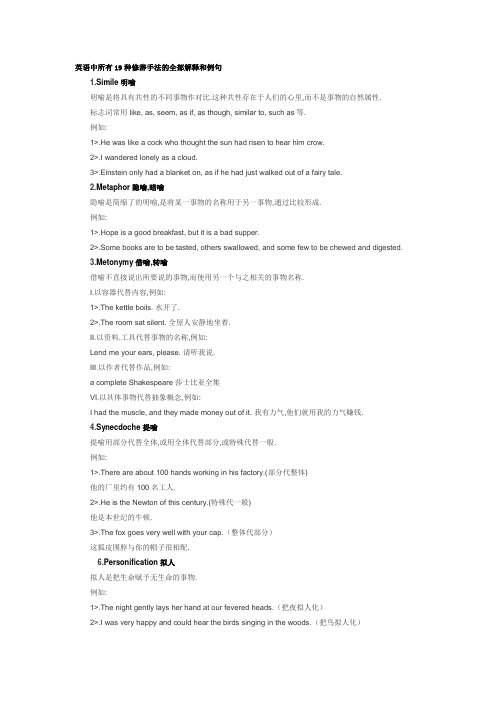
英语中所有19种修辞手法的全部解释和例句1.Simile 明喻明喻是将具有共性的不同事物作对比.这种共性存在于人们的心里,而不是事物的自然属性.标志词常用 like, as, seem, as if, as though, similar to, such as等.例如:1>.He was like a cock who thought the sun had risen to hear him crow.2>.I wandered lonely as a cloud.3>.Einstein only had a blanket on, as if he had just walked out of a fairy tale.2.Metaphor 隐喻,暗喻隐喻是简缩了的明喻,是将某一事物的名称用于另一事物,通过比较形成.例如:1>.Hope is a good breakfast, but it is a bad supper.2>.Some books are to be tasted, others swallowed, and some few to be chewed and digested.3.Metonymy 借喻,转喻借喻不直接说出所要说的事物,而使用另一个与之相关的事物名称.I.以容器代替内容,例如:1>.The kettle boils. 水开了.2>.The room sat silent. 全屋人安静地坐着.II.以资料.工具代替事物的名称,例如:Lend me your ears, please. 请听我说.III.以作者代替作品,例如:a complete Shakespeare 莎士比亚全集VI.以具体事物代替抽象概念,例如:I had the muscle, and they made money out of it. 我有力气,他们就用我的力气赚钱.4.Synecdoche 提喻提喻用部分代替全体,或用全体代替部分,或特殊代替一般.例如:1>.There are about 100 hands working in his factory.(部分代整体)他的厂里约有100名工人.2>.He is the Newton of this century.(特殊代一般)他是本世纪的牛顿.3>.The fox goes very well with your cap.(整体代部分)这狐皮围脖与你的帽子很相配.6.Personification 拟人拟人是把生命赋予无生命的事物.例如:1>.The night gently lays her hand at our fevered heads.(把夜拟人化)2>.I was very happy and could hear the birds singing in the woods.(把鸟拟人化)7.Hyperbole 夸张夸张是以言过其实的说法表达强调的目的.它可以加强语势,增加表达效果..例如:1>.I beg a thousand pardons.2>.Love you. You are the whole world to me, and the moon and the stars.3>.When she heard the bad news, a river of tears poured out.9.Euphemism 委婉,婉辞法婉辞法指用委婉,文雅的方法表达粗恶,避讳的话.例如:1>.He is out visiting the necessary. 他出去方便一下.2>.His relation with his wife has not been fortunate. 他与妻子关系不融洽.3>.Deng Xiaoping passed away in 1997. (去世)11.Irony 反语反语指用相反意义的词来表达意思的作文方式.如在指责过失.错误时,用赞同过失的说法,而在表扬时,则近乎责难的说法.例如:1>.It would be a fine thing indeed not knowing what time it was in the morning.早上没有时间观念还真是一件好事啊(真实含义是应该明确早上的时间观念)2>"Of course, you only carry large notes, no small change on you. "the waiter said to the beggar.12.Pun 双关双关就是用一个词在句子中的双重含义,借题发挥.作出多种解释,旁敲侧击,从而达到意想不到的幽默.滑稽效果.它主要以相似的词形.词意和谐音的方式出现.例如:1>.She is too low for a high praise, too brown for a fair praise and too little for a great praise.2>.An ambassador is an honest man who lies abroad for the good of his country.3>.If we don't hang together, we shall hang separately.13.Parody 仿拟这是一种模仿名言.警句.谚语,改动其中部分词语,从而使其产生新意的修辞.例如:1>.Rome was not built in a day, nor in a year.2>.A friend in need is a friend to be avoided.3>.If you give a girl an inch nowadays she will make address of it.15.Antithesis 对照,对比,对偶这种修辞指将意义完全相反的语句排在一起对比的一种修辞方法.例如:1>.Not that I loved Caeser less but that I loved Romemore.2>.You are staying; I am going.3>.Give me liberty, or give me death.17.Oxymoron 反意法,逆喻这也是一种矛盾修辞法,用两种不相调和的特征形容一个事物,以不协调的搭配使读者领悟句中微妙的含义.例如:1>.No light, but rather darkness visible.没有光亮,黑暗却清晰可见2>.The state of this house is cheerless welcome.Transferred Epithet: (移就) It is a figure of speech where an epithet (an adjective ordescriptive phrase) is transferred from the noun it should rightly modify(修饰) to another to which itdoes not really apply or belong. For instance, I spent sleepless nights on my project.1. Rushing thongs, blinded by the darkness and smoke, rushed up on a street and down the next trampling the fallen in a crazy fruitless dash toward safety.(Robert Silverbury: Pompeii)在黑暗和浓烟中狂奔的人群,沿着大街小巷踏着倒下的躯体,慌乱而徒劳地向安全地方冲闯。
英语中19种修辞手法的全部解释和例句解析

8.Parallelism 排比, 平行
这种修辞法是把两个或两个以上的结构大 体相同或相似,意思相关,语气一致的短语. 句子排列成串,形成一个整体. 1>.No one can be perfectly free till all are free; no one can be perfectly moral till all are moral; no one can be perfectly happy till all are happy. 所有的人自由後,才能完全自由;所有的 人都有道德,才能完全合乎道德;所有的 人都幸福了,才能真正幸福。
2.Metaphor 隐喻,暗喻
隐喻是简缩了的明喻,是将某一事物 的名称用于另一事物,通过比较形成. 例如: 1>.Hope is a good breakfast, but it is a bad supper. 2>.Some books are to be tasted, others swallowed, and some few to be chewed and digested.
这种修辞是将一系列词语按照意念的大 小.轻重.深浅.高低等逐层渐进,最后达到 顶点.可以增强语势,逐渐加深读者印象. 例如: 1>.I am sorry, I am so sorry, I am so extremely sorry.
19.Anticlimax 渐降法
The duties of a soldier are to protect his country and peel potatoes.
11.Iro误时,用赞同过 失的说法,而在表扬时,则近乎责难的说 法. 1>.It would be a fine thing indeed not knowing what time it was in the morning. 早上没有时间观念还真是一件 好事啊(真实含义是应该明确早上的时 间观念)
英语中有19种修辞手法
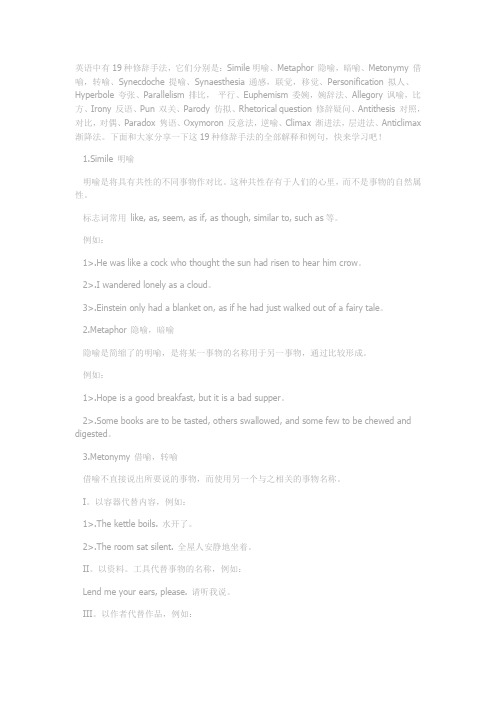
英语中有19种修辞手法,它们分别是:Simile明喻、Metaphor 隐喻,暗喻、Metonymy 借喻,转喻、Synecdoche 提喻、Synaesthesia 通感,联觉,移觉、Personification 拟人、Hyperbole 夸张、Parallelism 排比,平行、Euphemism 委婉,婉辞法、Allegory 讽喻,比方、Irony 反语、Pun 双关、Parody 仿拟、Rhetorical question 修辞疑问、Antithesis 对照,对比,对偶、Paradox 隽语、Oxymoron 反意法,逆喻、Climax 渐进法,层进法、Anticlimax 渐降法。
下面和大家分享一下这19种修辞手法的全部解释和例句,快来学习吧!1.Simile 明喻明喻是将具有共性的不同事物作对比。
这种共性存有于人们的心里,而不是事物的自然属性。
标志词常用like, as, seem, as if, as though, similar to, such as等。
例如:1>.He was like a cock who thought the sun had risen to hear him crow。
2>.I wandered lonely as a cloud。
3>.Einstein only had a blanket on, as if he had just walked out of a fairy tale。
2.Metaphor 隐喻,暗喻隐喻是简缩了的明喻,是将某一事物的名称用于另一事物,通过比较形成。
例如:1>.Hope is a good breakfast, but it is a bad supper。
2>.Some books are to be tasted, others swallowed, and some few to be chewed and digested。
十九种英语修辞手法的详细解释和例句
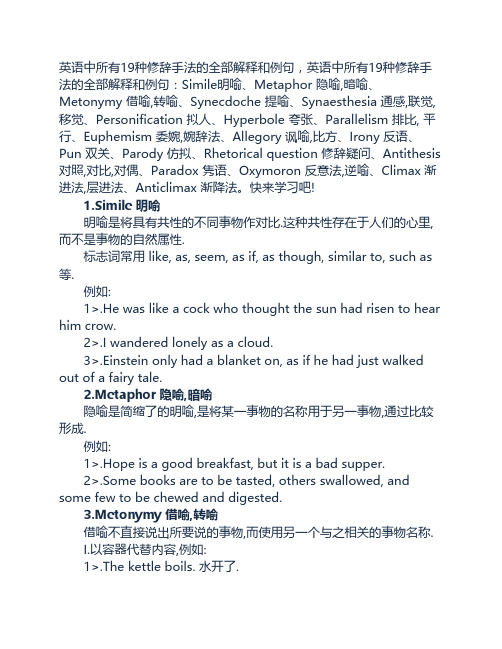
英语中所有19种修辞手法的全部解释和例句,英语中所有19种修辞手法的全部解释和例句:Simile明喻、Metaphor 隐喻,暗喻、Metonymy 借喻,转喻、Synecdoche 提喻、Synaesthesia 通感,联觉,移觉、Personification 拟人、Hyperbole 夸张、Parallelism 排比, 平行、Euphemism 委婉,婉辞法、Allegory 讽喻,比方、Irony 反语、Pun 双关、Parody 仿拟、Rhetorical question 修辞疑问、Antithesis 对照,对比,对偶、Paradox 隽语、Oxymoron 反意法,逆喻、Climax 渐进法,层进法、Anticlimax 渐降法。
快来学习吧! 1.Simile 明喻 明喻是将具有共性的不同事物作对比.这种共性存在于人们的心里,而不是事物的自然属性. 标志词常用 like, as, seem, as if, as though, similar to, such as 等. 例如: 1>.He was like a cock who thought the sun had risen to hear him crow. 2>.I wandered lonely as a cloud. 3>.Einstein only had a blanket on, as if he had just walked out of a fairy tale. 2.Metaphor 隐喻,暗喻 隐喻是简缩了的明喻,是将某一事物的名称用于另一事物,通过比较形成. 例如: 1>.Hope is a good breakfast, but it is a bad supper. 2>.Some books are to be tasted, others swallowed, and some few to be chewed and digested. 3.Metonymy 借喻,转喻 借喻不直接说出所要说的事物,而使用另一个与之相关的事物名称. I.以容器代替内容,例如: 1>.The kettle boils. 水开了. 2>.The room sat silent. 全屋人安静地坐着. II.以资料.工具代替事物的名称,例如: Lend me your ears, please. 请听我说. III.以作者代替作品,例如: a complete Shakespeare 莎士比亚全集 VI.以具体事物代替抽象概念,例如: I had the muscle, and they made money out of it. 我有力气,他们就用我的力气赚钱. 4.Synecdoche 提喻 提喻用部分代替全体,或用全体代替部分,或特殊代替一般. 例如: 1>.There are about 100 hands working in his factory.(部分代整体) 他的厂里约有100名工人. 2>.He is the Newton of this century.(特殊代一般) 他是本世纪的牛顿. 3>.The fox goes very well with your cap.(整体代部分) 这狐皮围脖与你的帽子很相配. 5.Synaesthesia 通感,联觉,移觉 这种修辞法是以视.听.触.嗅.味等感觉直接描写事物.通感就是把不同感官的感觉沟通起来,借联想引起感觉转移,“以感觉写感觉”。
英语中种修辞手法的全部解释和例句讲课教案

6.Personification 拟人
拟人是把生命赋予无生命的事物. 例如: 1>.The night gently lays her hand at
our fevered heads.(把夜拟人化)
7.Hyperbole 夸张
夸张是以言过其实的说法表达强调的目 的.它可以加强语势,增加表达效果:
11.Irony 反语
反语指用相反意义的词来表达意思的作 文方式.如在指责过失.错误时,用赞同过 失的说法,而在表扬时,则近乎责难的说 法.
1>.It would be a fine thing indeed not
knowing what time it was in the morning.
3.Metonymy 借喻,转喻
借喻不直接说出所要说的事物,而使用另一个与 之相关的事物名称.
I.以容器代替内容,例如: 1>.The kettle boils. 水开了. 2>.The room sat silent. 全屋人安静地坐着. II.以资料.工具代替事物的名称,例如: Lend me your ears, please. 请听我说. III.以作者代替作品,例如: a complete Shakespeare 莎士比亚全集 VI.以具体事物代替抽象概念,例如: I had the muscle, and they made money out
所有的人自由後,才能完全自由;所有的 人都有道德,才能完全合乎道德;所有的 人都幸福了,才能真正幸福。
9.Euphemism 委婉,婉辞法
婉辞法指用委婉,文雅的方法表达粗恶, 避讳的话.
He is out visiting the necessary. 他出去 方便一下.
英文中最常见的20种修辞手法(解释例句)
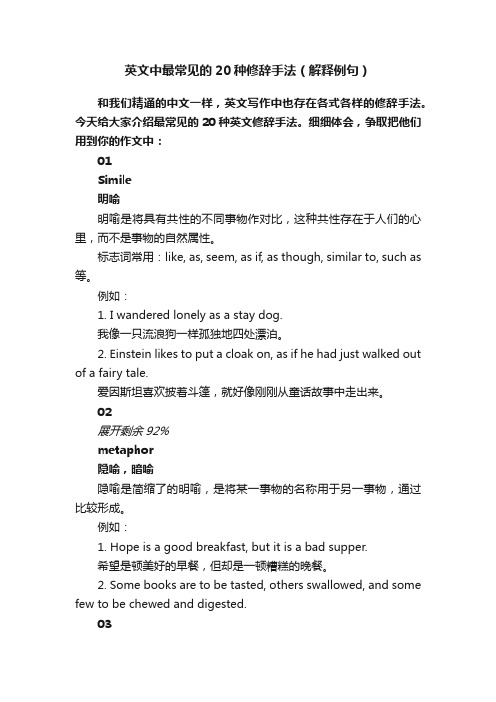
英文中最常见的20种修辞手法(解释例句)和我们精通的中文一样,英文写作中也存在各式各样的修辞手法。
今天给大家介绍最常见的20种英文修辞手法。
细细体会,争取把他们用到你的作文中:01Simile明喻明喻是将具有共性的不同事物作对比,这种共性存在于人们的心里,而不是事物的自然属性。
标志词常用:like, as, seem, as if, as though, similar to, such as 等。
例如:1. I wandered lonely as a stay dog.我像一只流浪狗一样孤独地四处漂泊。
2. Einstein likes to put a cloak on, as if he had just walked out of a fairy tale.爱因斯坦喜欢披着斗篷,就好像刚刚从童话故事中走出来。
02展开剩余92%metaphor隐喻,暗喻隐喻是简缩了的明喻,是将某一事物的名称用于另一事物,通过比较形成。
例如:1. Hope is a good breakfast, but it is a bad supper.希望是顿美好的早餐,但却是一顿糟糕的晚餐。
2. Some books are to be tasted, others swallowed, and some few to be chewed and digested.03metonymy借喻,转喻借喻不直接说出所要说的事物,而使用另一个与之相关的事物名称.1. 以容器代替内容,例如:1)The kettle boils.水开了。
2)The room sat silent.全屋人安静地坐着。
2. 以资料、工具代替事物的名称,例如:Lend me your ears, please.请听我说。
3. 以作者代替作品,例如:a complete Shakespeare莎士比亚全集4. 以具体事物代替抽象概念,例如:I had the muscle, and they made money out of it.我有力气,他们就用我的力气赚钱。
十九种英语修辞手法的详细解释和例句
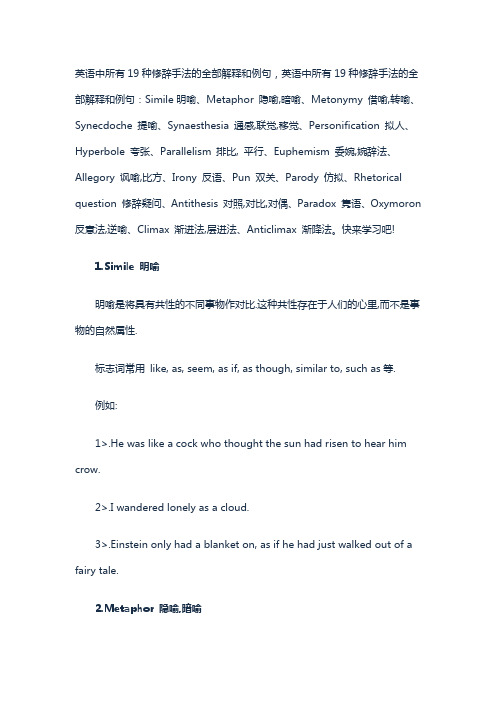
英语中所有19种修辞手法的全部解释和例句,英语中所有19种修辞手法的全部解释和例句:Simile明喻、Metaphor 隐喻,暗喻、Metonymy 借喻,转喻、Synecdoche 提喻、Synaesthesia 通感,联觉,移觉、Personification 拟人、Hyperbole 夸张、Parallelism 排比, 平行、Euphemism 委婉,婉辞法、Allegory 讽喻,比方、Irony 反语、Pun 双关、Parody 仿拟、Rhetorical question 修辞疑问、Antithesis 对照,对比,对偶、Paradox 隽语、Oxymoron 反意法,逆喻、Climax 渐进法,层进法、Anticlimax 渐降法。
快来学习吧!1.Simile 明喻明喻是将具有共性的不同事物作对比.这种共性存在于人们的心里,而不是事物的自然属性.标志词常用like, as, seem, as if, as though, similar to, such as等.例如:1>.He was like a cock who thought the sun had risen to hear him crow.2>.I wandered lonely as a cloud.3>.Einstein only had a blanket on, as if he had just walked out of a fairy tale.2.Metaphor 隐喻,暗喻隐喻是简缩了的明喻,是将某一事物的名称用于另一事物,通过比较形成.例如:1>.Hope is a good breakfast, but it is a bad supper.2>.Some books are to be tasted, others swallowed, and some few to be chewed and digested.3.Metonymy 借喻,转喻借喻不直接说出所要说的事物,而使用另一个与之相关的事物名称.I.以容器代替内容,例如:1>.The kettle boils. 水开了.2>.The room sat silent. 全屋人安静地坐着.II.以资料.工具代替事物的名称,例如:Lend me your ears, please. 请听我说.III.以作者代替作品,例如:a complete Shakespeare 莎士比亚全集VI.以具体事物代替抽象概念,例如:I had the muscle, and they made money out of it. 我有力气,他们就用我的力气赚钱.4.Synecdoche 提喻提喻用部分代替全体,或用全体代替部分,或特殊代替一般.例如:1>.There are about 100 hands working in his factory.(部分代整体)他的厂里约有100名工人.2>.He is the Newton of this century.(特殊代一般)他是本世纪的牛顿.3>.The fox goes very well with your cap.(整体代部分)这狐皮围脖与你的帽子很相配.5.Synaesthesia 通感,联觉,移觉这种修辞法是以视.听.触.嗅.味等感觉直接描写事物.通感就是把不同感官的感觉沟通起来,借联想引起感觉转移,“以感觉写感觉”。
英语中19种修辞手法和例句

1.Simile 明喻明喻是将具有共性的不同事物作对比.这种共性存在于人们的心里,而不是事物的自然属性.标志词常用 like, as, seem, as if, as though, similar to, such as等.例如:1>.He was like a cock who thought the sun had risen to hear him crow.2>.I wandered lonely as a cloud.3>.Einstein only had a blanket on, as if he had just walked out of a fairy tale.2.Metaphor 隐喻,暗喻隐喻是简缩了的明喻,是将某一事物的名称用于另一事物,通过比较形成.例如:1>.Hope is a good breakfast, but it is a bad supper.2>.Some books are to be tasted, others swallowed, and some few to be chewed and digested.3.Metonymy 借喻,转喻借喻不直接说出所要说的事物,而使用另一个与之相关的事物名称.I.以容器代替内容,例如:1>.The kettle boils. 水开了.2>.The room sat silent. 全屋人安静地坐着.II.以资料.工具代替事物的名称,例如:Lend me your ears, please. 请听我说.III.以作者代替作品,例如:a complete Shakespeare 莎士比亚全集VI.以具体事物代替抽象概念,例如:I had the muscle, and they made money out of it. 我有力气,他们就用我的力气赚钱.4.Synecdoche 提喻提喻用部分代替全体,或用全体代替部分,或特殊代替一般.例如:1>.There are about 100 hands working in his factory.(部分代整体)他的厂里约有100名工人.2>.He is the Newton of this century.(特殊代一般)他是本世纪的牛顿.3>.The fox goes very well with your cap.(整体代部分)这狐皮围脖与你的帽子很相配.5.Synaesthesia 通感,联觉,移觉这种修辞法是以视.听.触.嗅.味等感觉直接描写事物.通感就是把不同感官的感觉沟通起来,借联想引起感微风过处送来缕缕清香,仿佛远处高楼上渺茫的歌觉转移,“以感觉?写感觉”。
- 1、下载文档前请自行甄别文档内容的完整性,平台不提供额外的编辑、内容补充、找答案等附加服务。
- 2、"仅部分预览"的文档,不可在线预览部分如存在完整性等问题,可反馈申请退款(可完整预览的文档不适用该条件!)。
- 3、如文档侵犯您的权益,请联系客服反馈,我们会尽快为您处理(人工客服工作时间:9:00-18:30)。
英语修辞手法得解释与例句1.Simile明喻明喻就是将具有共性得不同事物作对比。
这种共性存在于人们得心里,而不就是事物得自然属性、标志词常用like, as, seem, as if, asthough, similar to, such as等.例如:1>、He was like acockwho thought the sun had risento hear him crow、2>。
I wandered lonelyas a cloud.3〉、Einstein only had a blanket on, as if he hadjust walked out o fa fairy tale.2。
Metaphor 隐喻,暗喻隐喻就是简缩了得明喻,就是将某一事物得名称用于另一事物,通过比较形成。
例如:1>、Hope isagood breakfast, but it is a badsupper、2〉.Somebooks are to be tasted, othersswallowed, andsome few to bechewedand digested、3。
Metonymy 借喻,转喻借喻不直接说出所要说得事物,而使用另一个与之相关得事物名称、I、以容器代替内容,例如:1〉。
The kettle boils、水开了、2〉.The room satsilent、全屋人安静地坐着。
II、以资料、工具代替事物得名称,例如:Lend me your ears, please。
请听我说。
III、以作者代替作品,例如:a plete Shakespeare 莎士比亚全集VI。
以具体事物代替抽象概念,例如:Ihad the muscle, and they made money outof it、我有力气,她们就用我得力气赚钱.4、Synecdoche提喻提喻用部分代替全体,或用全体代替部分,或特殊代替一般、例如:1〉。
There are about100hands working in his factory、(部分代整体) 她得厂里约有100名工人。
2>.Heis the Newton of thiscentury、(特殊代一般)她就是本世纪得牛顿。
3〉、The foxgoes very well with yourcap。
(整体代部分)这狐皮围脖与您得帽子很相配.5.Synaesthesia 通感,联觉,移觉这种修辞法就是以视.听、触。
嗅.味等感觉直接描写事物.通感就就是把不同感官得感觉沟通起来,借联想引起感觉转移,“以感觉写感觉"。
通感技巧得运用,能突破语言得局限,丰富表情达意得审美情趣,起到增强文采得艺术效果、比如:欣赏建筑得重复与变化得样式会联想到音乐得重复与变化得节奏;闻到酸得东西会联想到尖锐得物体;听到飘渺轻柔得音乐会联想到薄薄得半透明得纱子;又比如朱自清《荷塘月色》里得“ 微风过处送来缕缕清香,仿佛远处高楼上渺茫得歌声似得"、例如:1>.The birdssatupon a tree and pouredforth their lily like voice.(用视觉形容听觉,鸟落在树上,由它发出得声音联想到百合花)鸟儿落在树上,倾泻出百合花似得声音。
2>、Tastethe music of Mozart、(用嗅觉形容听觉)品尝Mozart得音乐。
6.Personification 拟人拟人就是把生命赋予无生命得事物。
例如:1>。
The nightgently laysher handat our fevered heads、(把夜拟人化)2〉、I was very happy and could hear the birdssinging in the woods、(把鸟拟人化)7。
Hyperbole夸张夸张就是以言过其实得说法表达强调得目得。
它可以加强语势,增加表达效果。
例如:1〉.I bega thousand pardons、2>.Loveyou、You are the whole world to me, and the moonand the stars、3〉、When she heard the badnews, a riverof tears poured out、8。
Parallelism 排比, 平行这种修辞法就是把两个或两个以上得结构大体相同或相似,意思相关,语气一致得短语、句子排列成串,形成一个整体、例如:1>。
No onecan be perfectly freetill allare free; no one can be perfectly moral till all are moral; noone canbeperfectlyhappy tillall are happy.2>。
Inthe dayswhen allthese things are tobe answered for, Isummon you andyours, to the last of your bad race, to answer for them。
In the days when all thesethingsare tobe answered for, I summonyourbrother, the worst ofyourbadrace, toanswer for them separately。
9、Euphemism 委婉,婉辞法婉辞法指用委婉,文雅得方法表达粗恶,避讳得话、例如:1>。
Heis out visitingthe necessary、她出去方便一下.2>.His relation with hiswife has not been fortunate、她与妻子关系不融洽。
3〉、DengXiaopingpassedaway in 1997、(去世)10.Allegory 讽喻,比方(原意“寓言”)建立在假借过去或别处得事例与对象之上,传达暗示,影射或者讥讽现世各种现象得含义。
英文解释:an expressive style that uses fictional characters and events to describe some subject by suggestiveresemblances; an extended metaphor摘自英语专业《大学英语教程》一书这就是一种源于希腊文得修辞法,意为”换个方式得说法”。
它就是一种形象得描述,具有双重性,表层含义与真正意味得就是两回事.例如:1〉、Make the haywhilethe sun shines、2>。
It's timeto表层含义:趁着出太阳得时候晒草ﻫﻫ真正意味:趁热打铁ﻫturnplough into sword、表层含义:就是时候把犁变成剑11。
Irony 反语反语指用相反意义得词来表达意思得作文方式。
如在指责过失、错误时,用赞同过失得说法,而在表扬时,则近乎责难得说法.1>.Itwould be a fine thing indeed not knowingwhat timeit was in the morning、早上没有时间观念还真就是一件好事啊(真实含义就是应该明确早上得时间观念)2>”Ofcourse, youonly carrylargenotes, no smallchange on you。
”the waiter saidto the beggar、Sarcasm: (讽刺)Sarcasm isa strong formof irony。
It attacks in a taunting and bitter manner,and its aimisto disparage, ridicule and wound thefeelings of the subject attacked、For example,laws are like cobwebs, which may catch small flies,but let waspsbreak through。
I love beingmarried。
It’s so great tofind that onespecial person you want to annoyfor the rest of your lifeI'd insult you, but you'renot bright enoughto notice、Not allmen are annoying。
Someare dead、Ridicule嘲弄Is unkind laughter or remarks intended to makesomeone or s omething seem stupid.Eg. He mopped his bald dome insilence。
Bryan, ageing andpaunchy, was assisted、Innuendo: (暗讽) It isa mildformof irony,hinting in a rather roundabout (曲折)way atsomething disparaging(不一致) or unplime ntary(不赞美)tothe person or subject mentioned、For example, the weathermansaid it would be worm、He must tak ehis readings in abathroom。
Innuendoandirony differ from each other。
With irony, the intended meaning isexplicit: it isexpressed by theoppositeof the literalmeaningof theword used。
Incontrast, with innuendo, the intend edmeaning is implicit andthe understanding of itdepends on the context。
That’s why innuendo is also called“a mild irony”.pare the i nnuendoremarks with the plainstatement in the brackets.12。
Pun 双关双关就就是用一个词在句子中得双重含义,借题发挥、作出多种解释,旁敲侧击,从而达到意想不到得幽默.滑稽效果、它主要以相似得词形。
